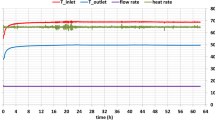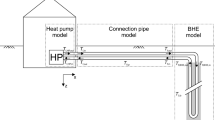Abstract
In this paper, a variable heating strength model (VHS model) is developed to predict transient heat conduction from a vertical rod buried in a semi-infinite medium. Unlike past studies, the current VHS model permits a VHS along the rod. Both axial heat conduction through the rod and lateral heat conduction to the surrounding ground are modeled. A derived distribution of axial heating strength is then applied to a finite line heat source model to predict transient temperature changes in the surrounding medium. The predicted results show how the rod’s radius and ground’s thermal conductivity affect the vertical variation of heating strength and temperature response. Additional simulations predict the long-term temperature increase in the ground, due to a power transmission tower installed in a region of initially frozen ground.











Similar content being viewed by others
Abbreviations
- A c :
-
cross-sectional area (m2)
- D :
-
diameter (m)
- H :
-
height (m)
- h :
-
heat transfer coefficient (W/m2 K)
- k :
-
thermal conductivity (W/m K)
- L :
-
length (m)
- q′′:
-
heat flow rate per unit area (W/m2)
- R :
-
radius (m)
- R′:
-
thermal resistance (Km/W)
- T :
-
temperature (K)
- z :
-
vertical coordinate (m)
- Q :
-
total heat flow rate (W)
- q :
-
heating strength (W/m)
- m :
-
coefficient defined in Eq. 9 (1/m2)
- α:
-
thermal diffusivity (m2/s)
- ρ:
-
radial coordinate (m)
- θ:
-
temperature response or difference (K)
- b:
-
rod/tower
- b0:
-
ground surface level of the rod
- c:
-
fluid
- g:
-
heat conduction medium (ground)
- gs:
-
surface of medium
- pf:
-
pin fin
References
Breger DS, Hubbell JE, El Hasnaoui H, Sunderland JE (1996) Thermal energy storage in the ground: comparative analysis of heat transfer modeling using U-tubes and boreholes. Solar Energy 56(6):493–503
Lund PD, Ostman MB (1985) A numerical model for seasonal storage of solar heat in the ground by vertical pipes. Solar Energy 34(4):351–366
Rabin EK (1996) Thermal analysis of a helical heat exchanger for ground thermal energy storage in arid zones. Int J Heat Mass Transf 39(5):1051–1065
Zeng HY, Diao NR, Fang ZH (2002) A finite line-source model for boreholes in geothermal heat exchangers. Heat Transf-Asian Res 31(7):558–567
Liu X, Wang D, Fang Z (2001) Modeling on heat transfer of a vertical bore in geothermal heat exchangers. Build Energy Environ 20:1–3
Bi Y, Chen L, Wu C (2002) Ground heat exchanger temperature distribution analysis and experimental verification. Appl Therm Eng 22(2):183–189
Deng Y, Fedler CB (1992) Multi-layered soil effects on vertical ground-coupled heat pump design. Trans ASAE 35(2):687–694
Pearson SW (1979) Thermal performance verification of thermal vertical support members for the trans-alaska pipeline. J Energy Resour Technol 101:225–231
Eckert ERG, Drake RM Jr (1972) Analysis of heat and mass transfer. McGraw-Hill, New York, pp. 103–106
Yang S (1993) Heat transfer, 2nd edn. Higher Education Press, pp. 43–46
Incropera FP, DeWitt DP (1996) Fundamentals of heat and mass transfer, 4th edn. Wiley, New York
Naterer GF (1996) Conduction shape factors of long polygonal fibres in a matrix. Numer Heat Transf A 30(7):721–738
Anteby I, Shai I (1993) Modified conduction shape factors for isothermal bodies embedded in a semi-infinite medium. Numer Heat Transf A 23(2):233–245
Chung M, Jung P, Rangel RH (1999) Semi-analytical solution for heat transfer from a buried pipe with convection on the exposed surface. Int J Heat Mass Transf 42(20):3771–3786
Sodha MS, Sawhney RL, Sengupta A (1994) Shape factor for an underground vertical infinite cylindrical structure. Int J Energy Res 18(4):431–436
Fang T (2004) Similarity solutions for heat conduction in a semi-infinite medium with power law thermal conductivity. Int Commun Heat Mass Transf 31(4):477–485
Naterer GF (2001) Applying heat-entropy analogies with experimental studies of interface tracking in phase change heat transfer. Int J Heat Mass Transf 44(15):2917–2932
Gau C, Viskanta R (1984) Melting and solidification of a metal system in a rectangular cavity. Int J Heat Mass Transf 27:113–123
Ho CJ, Viskanta R (1984) Heat transfer during melting from an isothermal vertical wall. ASME J Heat Transf 106:12–19
Kowalewski TA, Cybulski A, Rebow M (1998) Particle image velocimetry and thermometry in freezing water. In: 8th international symposium on flow visualization
Wisniewski TS, Kowalewski TA, Rebow M (1998) Infrared and liquid crystal thermography in natural convection. In: 8th international symposium on flow visualization
Yavuzturk C, Spitler JD (1999) A short time step response factor model for vertical ground loop heat exchangers. ASHRAE Trans 105(2):475–485
Carslaw HS, Jeager JC (1993) Conduction of heat in solids, 2nd edn. Oxford University Press, Oxford
Ingersoll LR, Zobe OJ, Ingersoll AC (1954) Heat conduction with engineering, geological and other applications. Revised Edition, The University of Wisconsin Press
Hart DP, Couvillion R (1986) Earth-coupled heat transfer, Dublin, OH, National Water Well Association, pp 11 – 16
Beier RA, Smith MD (2002) Borehole thermal resistance from line-source model of in-situ tests. ASHRAE Trans 108:2112–2119
Naterer GF (2003) Heat Transfer in single and multiphase systems. CRC, Boca Raton
A solar design manual for Alaska, University of Alaska, Fairbanks Cooperative Extension Service Publications EEM-01255, http://www.uaf.edu/coop-ext/publications/eehpubs.html#eem
Lunardini VJ (1981) Heat transfer in cold climates. Van Nostrand Reinhold Co., New York
National climate data and information archive, http://www.climate.weatheroffice.ec.gc.ca/climateData/canada_e.html
Gosselin C, Mareschal J (2003) Variations in ground surface temperature histories in the Thompson Belt, Manitoba, Canada: environment and climate changes. Glob Planet Change 39:271–284
Hinkel KM (1997) Estimating seasonal values of thermal diffusivity in thawed and frozen soils using temperature time series. Cold Regions Sci Technol 26:1–15
Andersland OB, Ladanyi B (1994) An introduction to frozen ground engineering. Chapman & Hall, New York
Hammer TA, Ryan WL, Zirjacks WL (1985) Ground temperature observations. In: Thomas G. Krzewinski, Rupert G. Tart Jr (eds) Thermal design considerations in frozen ground engineering
Acknowledgements
Support of this research from Manitoba Hydro and NSERC (Natural Sciences and Engineering Research Council of Canada) is gratefully acknowledged.
Author information
Authors and Affiliations
Corresponding author
Rights and permissions
About this article
Cite this article
Duan, X., Naterer, G.F., Lu, M. et al. Transient heat conduction from a vertical rod buried in a semi-infinite medium with variable heating strength. Heat Mass Transfer 43, 547–557 (2007). https://doi.org/10.1007/s00231-006-0124-8
Received:
Accepted:
Published:
Issue Date:
DOI: https://doi.org/10.1007/s00231-006-0124-8




